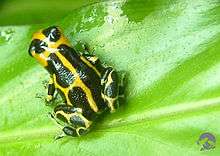Mimic poison frog
| Mimic poison frog | |
|---|---|
 | |
| Scientific classification | |
| Kingdom: | Animalia |
| Phylum: | Chordata |
| Class: | Amphibia |
| Order: | Anura |
| Suborder: | Neobatrachia |
| Family: | Dendrobatidae |
| Genus: | Ranitomeya |
| Species: | R. imitator |
| Binomial name | |
| Ranitomeya imitator (Schulte, 1986) | |
| Synonyms | |
|
Dendrobates imitator Schulte, 1986 | |
Ranitomeya imitator (formerly Dendrobates imitator), is a species of poison dart frog found in the north-central region of eastern Peru. Its common name is mimic poison frog,[1] and it is one of the best known dart frogs.[2] It was discovered in the late 1980s by Rainer Schulte who later split it up into more subspecies; describing each as a specific color morph, and sometimes having a separate behavioral pattern. The acoustics, morphs, and behavior of the species have been extensively researched.[2]
Morphology
A few of the morphs include, but are not limited to, striped, spotted, Varadero, and banded.[3] The striped morph is the most widely spread, mimicking the striped Ranitomeya variabilis and can be found throughout the lower Huallaga River drainage in Peru.[3] The spotted morph mimics the highland spotted frog Ranitomeya variabilis with mainly blue-green coloration, but can be found in other forms, sometimes in yellow.[3] The aradero morph is a lowland form that lives nearby another but does not resemble it.[3] Last, the banded morph, a mimic of Ranitomeya summersi, lives in much drier climates than the average R. imitator and is most often found in Dieffenbachia and Heliconia plants.[3]
Toxicity
Like most other Ranitomeya species, R. imitator has a mild toxicity compared to other poison dart frogs. It produces the potent pumiliotoxin B, but its small size limits the amount of poison it can secrete. Like other poison dart frogs, it does not produce toxin in captivity. It probably gains its poison from consuming toxic insects or other invertebrates in the wild. Frogs of the related genus Phyllobates may derive their toxins from local melyrid beetles of genus Choresine.[4]
Reproduction and parental care

Ranitomeya imitator and related frogs exhibit a degree of parental care, with the female laying feeder eggs for the tadpoles to eat. This frog is the first amphibian species in which the sexual partners have been shown to be monogamous.[5]
Ownership
Compared to many other dart frog species, Ranitomeya imitator has relatively large and stable wild populations.[6] However, they are often illegally collected and exported.[7] They have also been imported legally, and multiple captive-bred varieties exist in the pet trade.
References
- ↑ East Carolina University. March 12, 2010. Biologists find proof of first confirmed species of monogamous frog. ScienceDaily. Retrieved May 31, 2013.
- 1 2 J.L. Brown, E. Twomey (2011). “ZOOTAXA: A taxonomic revision of the Neotropical poison frog genus Ranitomeya (Amphibia: Dendrobatidae)” Magnolia Press pp. 68-72. In Schulte, Rainer (1989). “Eine Neue Dendrobates- Art aus Ostperu (Amphibia: Salentia: Dendrobatidae) pp. 11-21
- 1 2 3 4 5 Ranitomeya imitator”. dendrobates.org. In Schulte, Rainer (1989). “Eine Neue Dendrobates- Art aus Ostperu (Amphibia: Salentia: Dendrobatidae) Sauria 8(3): 11-20.
- ↑ Dumbacher, J. P., et al. (2004). Melyrid beetles (Choresine): A putative source for the batrachotoxin alkaloids found in poison-dart frogs and toxic passerine birds. Proceedings of the National Academy of Sciences of the United States of America 101(45) 15857-60.
- ↑ Brown, J. L., et al. (2010). A key ecological trait drove the evolution of biparental care and monogamy in an amphibian. The American Naturalist 175(4) 436–46.
- ↑ Javier Icochea, Ariadne Angulo, Karl-Heinz Jungfer 2004. Ranitomeya imitator. In: IUCN 2013. IUCN Red List of Threatened Species. Version 2013.1.
- ↑ Clare, John (July 30, 2011). “Clare, John (July 30, 2011). “Imitating Dart Frog, Ranitomeya imitator/Dendrobates imitator (Schulte, 1986) - Care and Breeding”. frogforum.net
| Wikispecies has information related to: Ranitomeya imitator |
